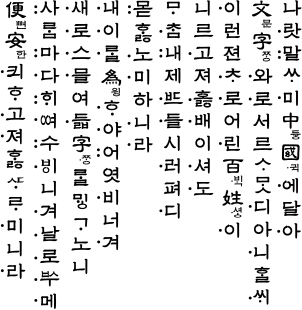1. The Creation of Hangul
In 1443, King Sejong created Hunminjeongeum with several scholars. Hunminjeongeum was created using scientific and orderly elements and in order to help citizens who were having trouble with learning and using Chinese characters. Hunminjeongeum was announced on 9th, October, 1446, about 3 years after it was created. However, it did not get treated well and was often called 'unmun' as a negative meaning. After Gabogaehyuk, it was renamed as Gukmoon, but it was actually after Korea had become free from Japan that Hunminjeongeum was named and announced as Hangul, the official language of Korea.
2. Hunminjeongeumhaeryebon Uhje Seomun
2. Hunminjeongeumhaeryebon Uhje Seomun

Hunminjeongeum Uhje Seomun contains the major background upon creation of Hunminjeongeum. There were mainly 3 reasons that King Sejong created Hunminjeongeum. One was to become independent linguistically, another was for the citizens, and the other was to create a practical language.
3. Difference Between Medieval and Modern Hangul
1) Medieval Hangul was written vertically and read from right to left.
2) There were a few characters which have now disappeared.
3) Habyong Byongseo characters could be on the first place of a syllable.
4) Some words' meanings changed over time.
5) Bangjums, which decided a syllable's pitch, were used.
6) A Chinese character's sound needed to be written down in a full syllable.
7) There were no spaces between words.
8) There were 8 characters which could be pronounced at the end of a syllable.
4. 28 Basic Characters of Hunminjeongeum
Hangul's characters are divided into 2 groups; consonants and vowels. The very basic 5 consonants were created by imitating the shape of a person's pronunciation organs. Strokes were added to these basic consonants as sound became stronger. The vowels, were created in a similar way. The basic 3 vowels were created by imitating the shape of the sky, ground, and a human being. Then, 4 characters were created by combining 2 of the basic 3 vowels together. By combining a basic vowel with these newly created 4 characters, additional 4 characters were created. There are also characters which are made by combining previously mentioned consonants and vowels together, but they are not considered as the basic characters of Hangul.
5. Hangul's Distinct Characteristics
Hangul is made using 3 major principles, so it is very scientific and is in order. That's why anyone can learn Hangul easily, and is proved by the low percentage of illiterate people in Korea. Moreover, Hangul uses characters which express the sound of a word, and each syllable can be separated into up to 3 parts, which is a unique characteristic of Hangul that cannot be found in any other languages in the world.
6. Our Experiences Regarding Hangul
6. Our Experiences Regarding Hangul
In front of the King Sejong Statue in Gwanghwamun
|
Inside Kyongbokgoong whre King Sejong created Hangul
|
With the original copy of Hunminjeongeumhaeryebon
|




